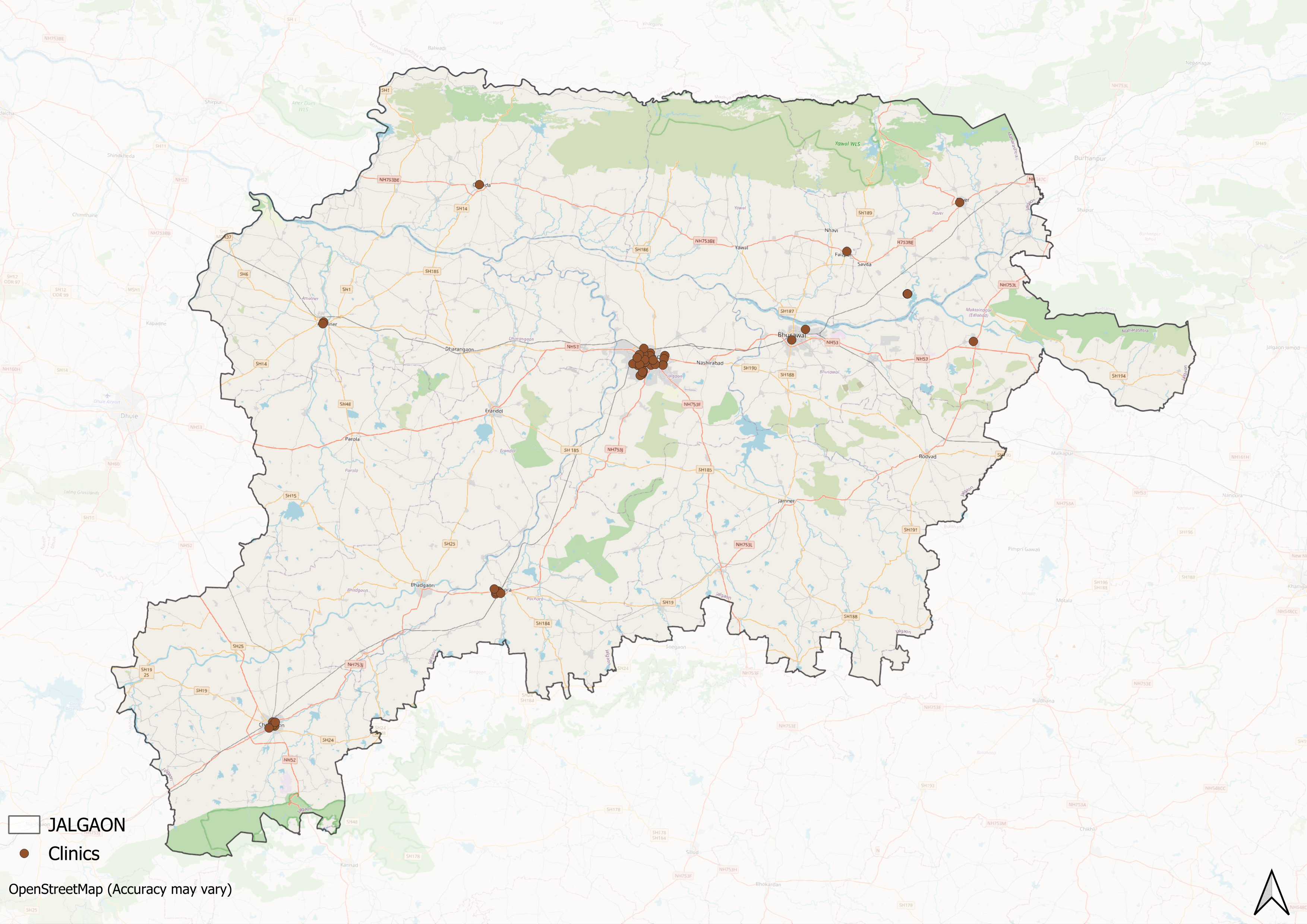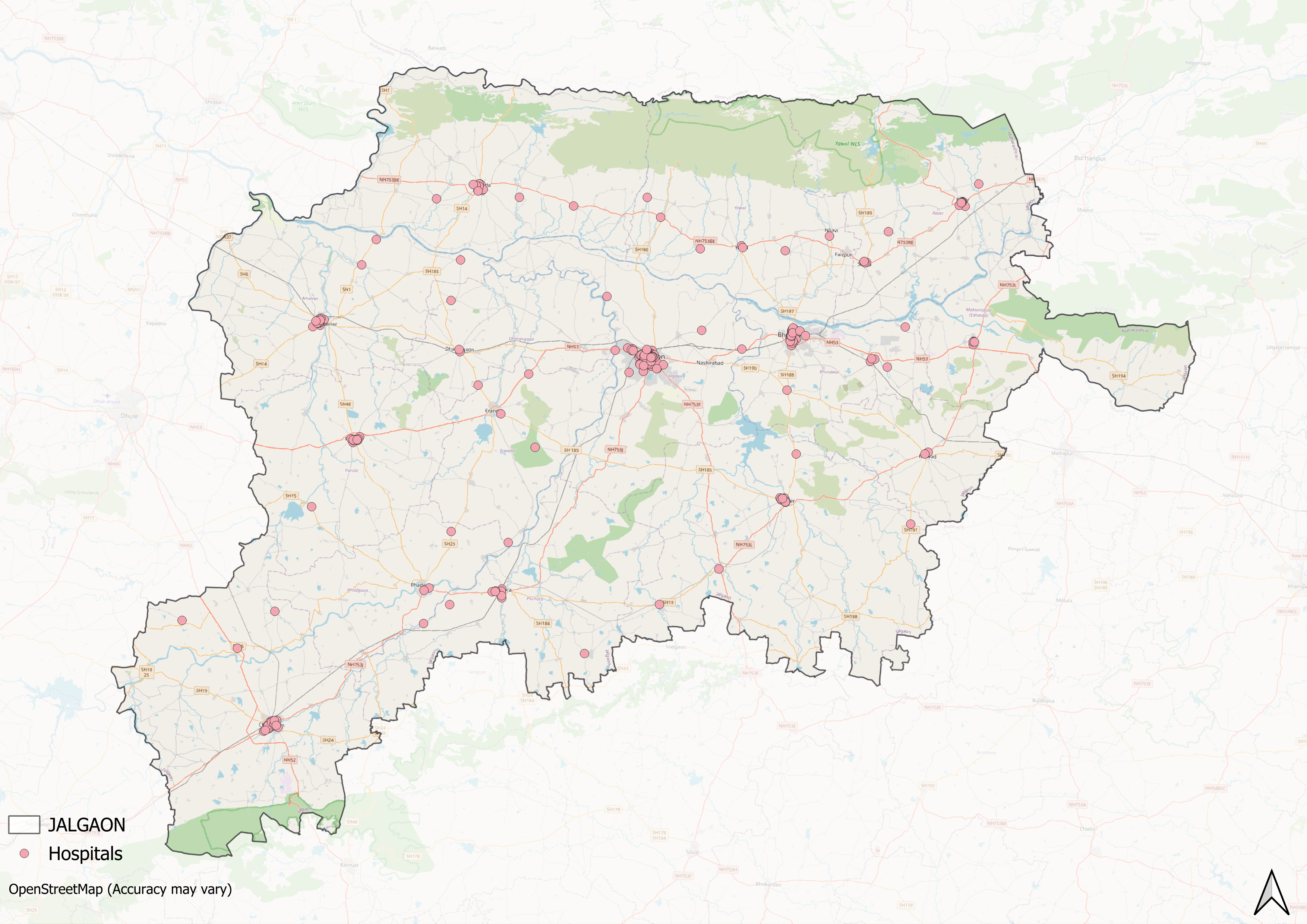Contents
- Healthcare Infrastructure
- NGOS & Initiatives
- Udan Disabled Training Centre
- Graphs
- Healthcare Facilities and Services
- A. Patients in In-Patients Department
- B. Patients in Outpatients Department
- C. Outpatient-to-Inpatient Ratio
- D. Operations Conducted
- E. Hysterectomies Performed
- F. Share of Households with Access to Health Amenities
- Morbidity and Mortality
- A. Reported Infant Deaths
- B. Select Causes of Infant Death
- C. Number of Children Diseased
- D. Population with High Blood Sugar
- E. Population with Very High Blood Sugar
- F. Population with Mildly Elevated Blood Pressure
- G. Population with Moderately or Severely High Hypertension
- H. Women Examined for Cancer
- I. Alcohol and Tobacco Consumption
- Maternal and Newborn Health
- A. Reported Deliveries
- B. Institutional Births: Public vs Private
- C. Home Births: Skilled vs Non-Skilled Attendants
- D. Live Birth Rate
- E. Still Birth Rate
- F. Maternal Deaths
- G. C-section Deliveries: Public vs Private
- H. Institutional Deliveries through C-Section
- I. Deliveries through C-Section: Public vs Private Facilities
- J. Reported Abortions
- K. Medical Terminations of Pregnancy: Public vs Private
- L. MTPs in Public Institutions before and after 12 Weeks
- M. Average Out of Pocket Expenditure per Delivery in Public Health Facilities
- N. Registrations for Antenatal Care
- O. Antenatal Care Registrations Done in First Trimester
- P. Iron Folic Acid Consumption Among Pregnant Women
- Q. Access to Postnatal Care from Health Personnel Within 2 Days of Delivery
- R. Children Breastfed within One Hour of Birth
- T. Children (6-23 months) Receiving an Adequate Diet
- T. Sex Ratio at Birth
- U. Births Registered with Civil Authority
- V. Institutional Deliveries through C-section
- W. C-section Deliveries: Public vs Private
- Family Planning
- A. Population Using Family Planning Methods
- B. Usage Rate of Select Family Planning Methods
- C. Sterilizations Conducted (Public vs Private Facilities)
- D. Vasectomies
- E. Tubectomies
- F. Contraceptives Distributed
- G. IUD Insertions: Public vs Private
- H. Female Sterilization Rate
- I. Women’s Unmet Need for Family Planning
- Immunization
- A. Infants Given the Oral Polio Vaccine
- C. Infants Given the Bacillus Calmette Guerin (BCG) Vaccine
- C. Infants Given Hepatitis Vaccine (Birth Dose)
- D. Infants Given the Pentavalent Vaccines
- E. Infants Given the Measles or Measles Rubella Vaccines
- F. Infants Given the Rotavirus Vaccines
- G. Fully Immunized Children
- H. Adverse Effects of Immunization
- I. Percentage of Children Fully Immunized
- J. Vaccination Rate (Children Aged 12 to 23 months)
- K. Children Primarily Vaccinated in (Public vs Private Health Facilities)
- Nutrition
- A. Children with Nutritional Deficits or Excess
- B. Population Overweight or Obese
- C. Population with Low BMI
- D. Prevalence of Anaemia
- E. Moderately Anaemic Women
- F. Women with Severe Anaemia being Treated at an Institution
- Sources
JALGAON
Health
Last updated on 26 July 2025. Help us improve the information on this page by clicking on suggest edits or writing to us.
Jalgaon’s healthcare landscape, like that of many other regions in India, has been shaped by a mix of indigenous and Western medical practices. For centuries, treatments based on local knowledge and provided by practitioners such as hakims and vaidyas formed the backbone of healthcare in the district. This deep connection between communities and their natural surroundings, in many ways, played a key role in shaping early medical traditions.
Over time, Jalgaon’s formal healthcare system began to take shape during the colonial period, with the Dharangaon Bhil Corps Hospital established in 1869. Since then, the district has continued to expand and develop its healthcare services.
Healthcare Infrastructure
Similar to other regions in India, Jalgaon’s healthcare infrastructure follows a multi-tiered system that involves both public and private sectors. The public healthcare system is structured into primary, secondary, and tertiary levels. Primary care is provided through Sub Centres and Primary Health Centres (PHCs), secondary care is managed by Community Health Centres (CHCs) and Sub-District hospitals, while tertiary care, the highest level, is delivered through Medical Colleges and District Hospitals.


Supporting this structure is a network of Accredited Social Health Activists (ASHAs) who, as described by the National Health Mission, serve as “an interface between the community and the public health system.” Supporting this structure is a network of Accredited Social Health Activists (ASHAs) who, as described by the National Health Mission, serve as “an interface between the community and the public health system.” Over time, this multi-layered model has been refined through national policies and reforms aimed at expanding universal health coverage.
Jalgaon’s formal healthcare system, like in many parts of India, began to take shape during the colonial era. As Rama Baru (1999) notes, “Allopathic medicine was introduced by the British in the mid-18th century, primarily to serve the needs of their civilian and military population.” In Jalgaon, the military presence appears to have shaped this early system. In 1869, the Dharangaon Bhil Corps Hospital was established to provide medical care exclusively for military personnel, with a capacity of eighteen beds for male patients.
To provide some basic medical services to people outside the military, the British administration also opened small dispensaries in different towns. One of the earliest of these in Jalgaon district was the Parola Dispensary, which was set up in 1869 to offer basic treatment for civilians.
![Civil Hospital, Jalgaon[1]](/media/statistic/images/maharashtra/jalgaon/health/civil-hospital-jalgaon1-db564b66.png)
After Independence, public healthcare gradually expanded to serve more people in the district. By around 1960, as noted in the 1961 Census, Jalgaon had three government-run hospitals. The Civil Hospital was the largest of these facilities and became a key centre for general healthcare. In the following decades, the district’s healthcare network grew further through government investment, the work of local trusts, and the involvement of non-governmental organisations and private practitioners.
Private hospitals have also added new services and specialities over time. Among some facilities that were established in relation to this and are well-known are Malti Accident Hospital, located in Bhaskar Market, which has provided orthopaedic services for about sixty years, and Naval Multispecialty Hospital, founded by Dr. Sudarshan Naval in 1982 as a 22-bed facility at J.M.P. Market. In 1998, Naval Hospital added operative gynaecological laparoscopy and set up Jalgaon’s first Test Tube Baby Centre.
NGOS & Initiatives
The determinants of health and health outcomes, as the World Health Organisation (WHO) elaborates, are not solely shaped by more than just medical factors and healthcare services. The organisation uses the term “social determinants of health (SDH)” to refer to the “non-medical factors that influence health outcomes.” These non-medical factors can be sanitation, nutrition, community well-being, or, as the WHO outlines, “income and social protection,” “food security,” access to quality healthcare, and more.
While there have been ongoing efforts to strengthen Jalgaon district’s healthcare infrastructure, certain areas still face challenges, particularly in addressing these broader health determinants. In response, non-governmental organisations have emerged as vital partners, working alongside public health systems to develop innovative, grassroots-level approaches that bridge these gaps.
Udan Disabled Training Centre
The Udan Disabled Training Centre is a facility in Jalgaon which was established by the Rushil Multipurpose Foundation, a local non-governmental organisation. The centre was founded by Mrs. Harshali Chaudhari, whose personal experiences led her to start an initiative focused not only on basic care but also on well-being and social inclusion for people with disabilities (aspects often overlooked in mainstream healthcare discourses).
![Udan Disabled Training Centre, Jalgaon[2]](/media/statistic/images/maharashtra/jalgaon/health/udan-disabled-training-centre-jalgaon2-731363ed.png)
In its early days, the centre operated from her home and focused on providing basic support and training. To help participants gain skills and income, the centre later introduced a sheltered workshop. This space allows people with disabilities to engage in craft and artistic work, receive vocational training, and earn wages in a supportive environment.
Graphs
Healthcare Facilities and Services
Morbidity and Mortality
Maternal and Newborn Health
Family Planning
Immunization
Nutrition
Sources
Alexander Kyd Nairne. 1896. Gazetteer Of The Bombay Presidency. Vol. I, Part II. The Government Central Press, Bombay.
Census of India. 1966. District Census Handbook: Jalgaon.Director, Government Printing and Stationery.
Census of India. 2001. District Census Handbook. Jalgaon. https://censusindia.gov.in/nada/index.php/catalog/27798https://censusindia.gov.in/nada/index.php/ca…
James M Campbell. 1880. Gazetteer Of Bombay Presidency: Khandesh, Vol. 12. Government Central Press, Bombay.
M Choksi, B. Patil et al. 2016. Health systems in India.Vol 36 (Suppl 3). Journal of Perinatology. https://pmc.ncbi.nlm.nih.gov/articles/PMC5144115/https://pmc.ncbi.nlm.nih.gov/articles/PMC514…
Maharashtra State Gazetteers. 1962. Jalgaon District. Directorate of Government Printing, Stationery & Publications, Government of Maharashtra, Mumbai.
Maharashtra State, Mumbai. https://censusindia.gov.in/nada/index.php/catalog/29181/download/32362/22694_1961_JAL.pdfhttps://censusindia.gov.in/nada/index.php/ca…
National Health Mission (NHM). "About Accredited Social Health Activist (ASHA)." National Health Mission, India. https://nhm.gov.in/index1.php?lang=1&level=1&sublinkid=150&lid=226#:~:text=One%20of%20the%20key%20components,performing%20her%20spelled%20out%20roles.https://nhm.gov.in/index1.php?lang=1&level=1…
Naval Hospital. "About Us." Naval Hospital, Jalgaon. https://www.navalhospital.in/about-us/https://www.navalhospital.in/about-us/
Rama Baru. 1999. “Missionaries in Medical Care.” Vol. 34, No. 9. Economic and Political Weekly. https://www.jstor.org/stable/4407696https://www.jstor.org/stable/4407696
Udaan NGO. "About Udaan." Udaan NGO, Jalgaon. http://udaan-ngo.org/abouthttp://udaan-ngo.org/about
Udaan NGO. "Activities of Udaan NGO." Udaan NGO, Jalgaon. http://udaan-ngo.org/activityhttp://udaan-ngo.org/activity
Last updated on 26 July 2025. Help us improve the information on this page by clicking on suggest edits or writing to us.